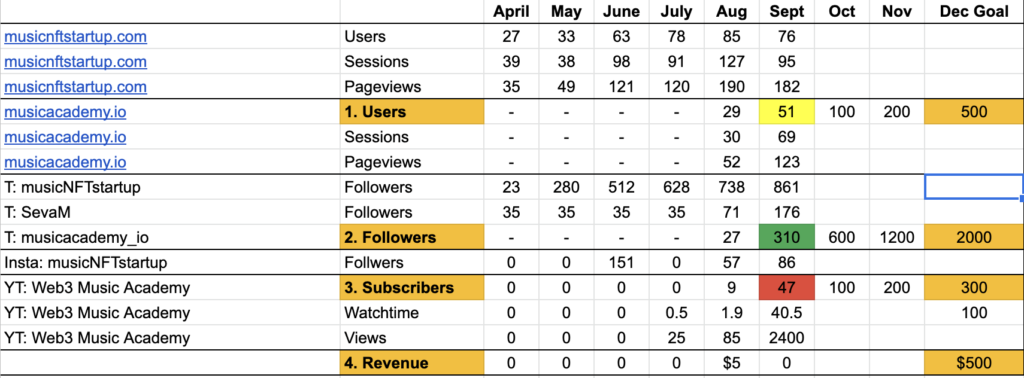We’ve started the Web3 Music Academy – the long sought web3 music business opportunity. This is a quick reflection on how things are going so far.
Building Roadmap for web3 business
If you have been following Music NFT Startup, you must have seen a number of reviews, whereby we spent 7 days with the different music NFT platforms, and tried it from the perspectives of music fans, NFT collectors, and musicians. We ran in-depth reviews of the features offered by the platforms, their tokenomics and business models, communities, and plans for the future.
These reviews and analyses gave us the necessary expertise in the area in general, and judging by how much positive feedback we’ve got, this is not something you can find in abundance, not even among the founders of a few Web3 music businesses who reached out to share knowledge on multiple occasions. This step was very necessary and we are still finalizing it in October 2022 – finishing the Melos.Studio review, and planning the last (10th) platform review to finish the cycle.
Mid-way we realized that the total number of platforms is far greater than 10, and we made a decision to prioritize them by popularity and impact. We excluded the general marketplaces from the list, such as OpenSea, so that we can focus on Web3 music platforms. To do that, we’ve built the database and started capturing the search volumes around these platforms over time, showing us whether the music industry is growing in Web3 and NFT space. It is growing, but we’ll get into details in materials published on Web3 Music Academy.
The next step in building our Web3 Music Academy is creating courses for the musicians who are entering Web3 and NFT markets. There is already an onboarding one covering the very foundations. The first one planned is going to help musicians self-assess their current status, provide an overview and cross-comparison of the music NFT platforms, and assist in choosing the next steps for development. The courses will be available on YouTube and on the Academy site as well.
Tools available for a web3 business
This site is built on WordPress, just like a third of the internet, and at the moment it looks like Web3 Music Academy will be using this engine for content management as well. It turns out there are already some plugins for WordPress, and if you register/log in to the Academy site, you will notice the “Login with Metamask” wallet button. Further to that, there are plugins available to collect donations in crypto. Finally, once we have a substantial amount of content on the site, we will leverage WordPress plugins that help hide and reveal content on the site based on the contents of your wallet.
The socials are currently on Web2. One may also ask about the choice of video streaming platform, YouTube, given that there are Web3 alternatives – but the answer to that is simple – we will be reaching out to folks who right now have very little idea about Web3, but they are on YouTube, Instagram, Twitter, and TikTok.
It is amazing to what extent the free tools and demo versions of paid ones can help run the business these days, and how much of them are applicable for both Web2 and Web3. Just a few examples of what I have been using until now:
- Lumen5 – creating professional video presentations, like the ones we have on our YouTube channel.
- Hootsuite – Scheduling social media posts. Additional value for us is the fact that you can duplicate the posts from the past and schedule them perhaps for a different timezone.
- Adobe Express and Canva – creating illustrations, presentations, and animations for social media and the website.
Further to that, people on services like Fiverr become more and more proficient navigating in Web3 and a number of services can now be outsourced. We have ordered a couple of gigs to boost our social media accounts, more specifically Twitter, Instagram, and YouTube, and we were cheap when selecting. The Twitter gig was about $12 including commission and brought about 220 followers both times. The freelancers advertise gigs directly aimed at NFT audience and mostly use the follow/unfollow method – they don’t post or comment on your behalf. The audience growing this way is organic, but not the most active or interested in your content. Similar observations go for Instagram.
The YouTube gig was just $7, and brought about 2.2K views and 44 subscribers to the channel. I’m a bit confused about the methodology they were using, but they guaranteed no bots, the users and viewers were from different geography, and the hours my videos were watched counted towards monetization. So, no complaints there, but we are yet to assess how active subscribers acquired this way are.
Goal setting in web3 music
We strongly believe in goal setting, although hoping to just overkill in each one of them by the end of this year. It is important to watch your analytics and understand where you are on the map in relation to where you are going. Here is the summary of what it looks like for us:

We are looking at a few things, obviously, but to keep our eyes on the ball, we highlighted those that would be our KPI, if we were to use that terminology. T on the picture stands for Twitter, Insta for Instagram, and YT for YouTube channel. The fourth one is currently to be figured out, but the plan is to create the community and then figure out the monetization. The $5 you see there in August is coming from a sale of a music NFT on Nina Protocol, which we reviewed that month. It was a very positive first sale. So, we have end-of-the-year goals and month-by-month stats of how we are progressing.
As mentioned above, we are taking a mixed approach in terms of building the number of followers and subscribers, some jumps in the metrics are caused by paid gigs, while the steady growth is led by organic content creation and marketing.


